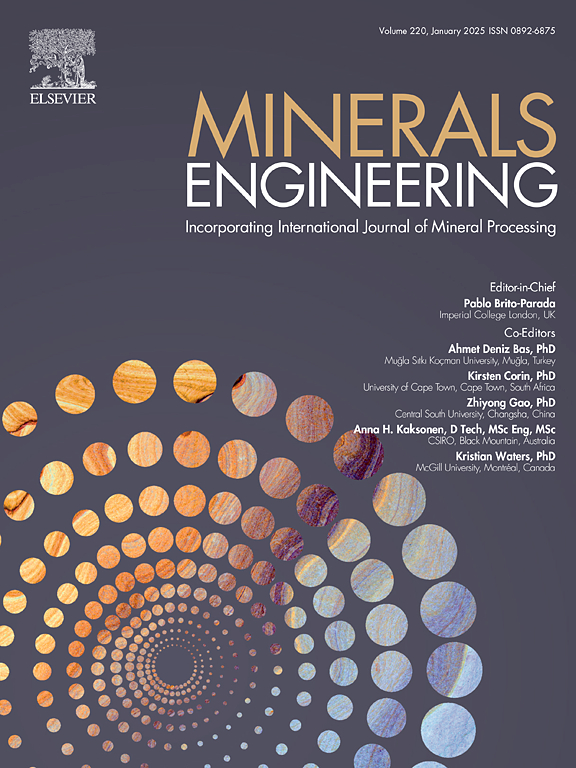Online particle-size monitoring for hydrocyclone overflow: Where is the beacon?
IF 4.9
2区 工程技术
Q1 ENGINEERING, CHEMICAL
引用次数: 0
Abstract
Monitoring the particle size-passing fraction (PSPF) at hydrocyclone overflow is critical for energy-efficient comminution and flotation. Knowledge of particle size distribution (PSD) beyond the single PSPF number can be yet more beneficial to plant operators. However, the large number of hydrocyclones typically employed in a processing plant and the necessity of monitoring each individual hydrocyclone unit have posed significant challenges to online PSPF and PSD monitoring. The questions are: What are the technologies available for online particle size assessment (PSA)? To what extent have these technologies been assisting the mining industry? Where is the beacon leading to a better solution? This paper reviews existing methods for PSPF and PSD online monitoring at hydrocyclones and classifies them into five categories — numerical, mechanical, attenuation, optical, and vibration. Evaluations are made in terms of online capability, system compactness, particle size range, performance robustness, measurement accuracy, maintenance requirements, and implementation costs, with comparison made and sensitivity analysis conducted. It reveals there is no single solution that excels in all evaluation criteria, and instead, different methods could mutually complement. Guidance is provided to assist the industry in selecting appropriate online PSA systems for hydrocyclone overflow based on different priorities. Data fusion and machine learning are recommended for further advancement in enhancing measurement accuracy and enabling self-calibration.
水力旋流器溢流粒径在线监测:信标在哪里?
水力旋流器溢流段粒度通过率(PSPF)的监测是实现高效粉碎浮选的关键。超过单一PSPF数的粒径分布(PSD)知识对工厂操作人员更有利。然而,处理厂通常使用大量的水力旋流器,并且需要监测每个单独的水力旋流器单元,这对PSPF和PSD的在线监测提出了重大挑战。问题是:哪些技术可用于在线粒径评估(PSA)?这些技术在多大程度上帮助了采矿业?指引我们找到更好解决方案的灯塔在哪里?综述了水力旋流器PSPF和PSD在线监测的现有方法,并将其分为数值法、力学法、衰减法、光学法和振动法五类。从在线能力、系统紧凑性、粒度范围、性能稳健性、测量精度、维护要求、实施成本等方面进行评价,并进行对比和敏感性分析。它揭示了没有单一的解决方案能够在所有的评估标准中都表现出色,相反,不同的方法可以相互补充。根据不同的优先级,为水力旋流器溢流选择合适的在线PSA系统提供了指导。数据融合和机器学习被推荐用于进一步提高测量精度和实现自校准。
本文章由计算机程序翻译,如有差异,请以英文原文为准。
求助全文
约1分钟内获得全文
求助全文
来源期刊

Minerals Engineering
工程技术-工程:化工
CiteScore
8.70
自引率
18.80%
发文量
519
审稿时长
81 days
期刊介绍:
The purpose of the journal is to provide for the rapid publication of topical papers featuring the latest developments in the allied fields of mineral processing and extractive metallurgy. Its wide ranging coverage of research and practical (operating) topics includes physical separation methods, such as comminution, flotation concentration and dewatering, chemical methods such as bio-, hydro-, and electro-metallurgy, analytical techniques, process control, simulation and instrumentation, and mineralogical aspects of processing. Environmental issues, particularly those pertaining to sustainable development, will also be strongly covered.
 求助内容:
求助内容: 应助结果提醒方式:
应助结果提醒方式:


